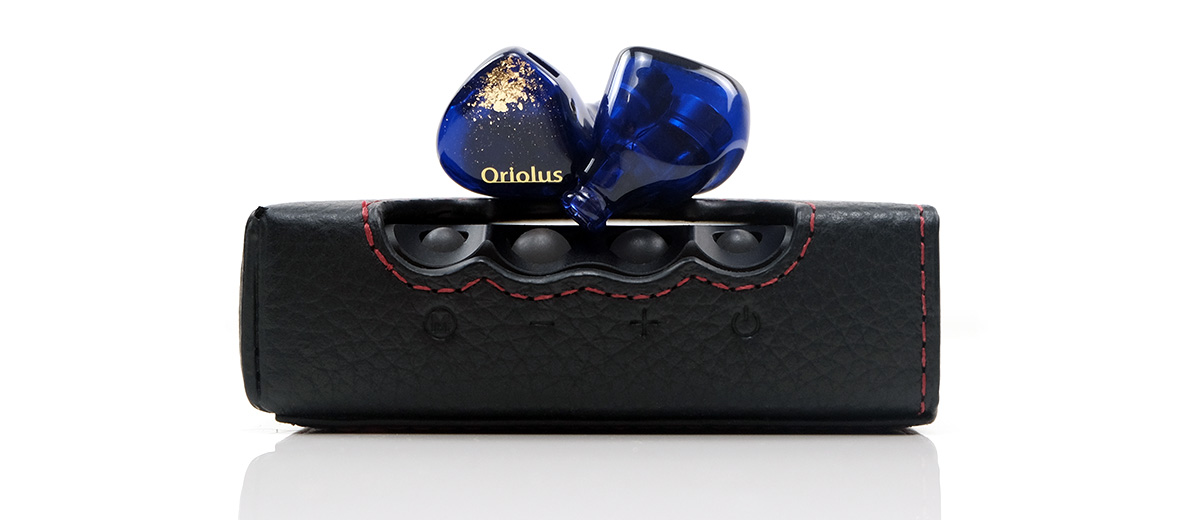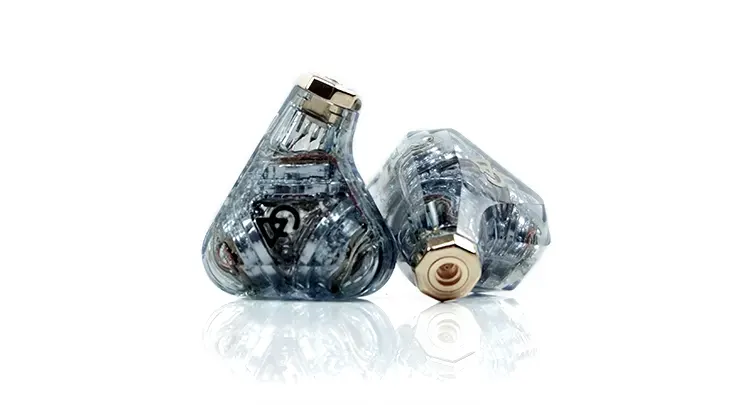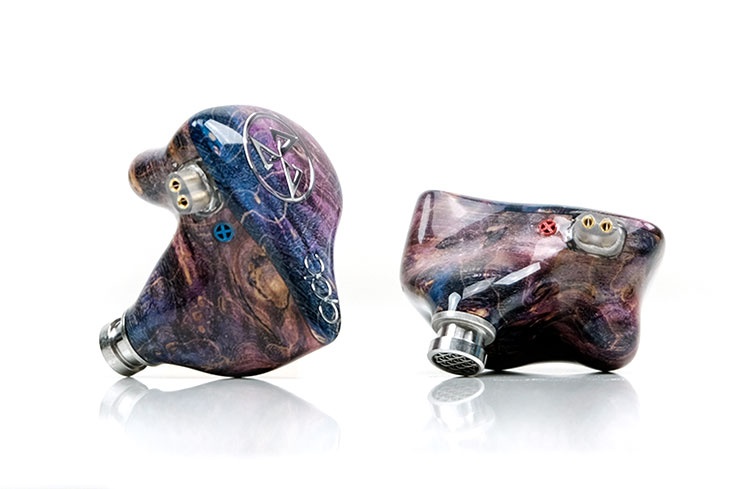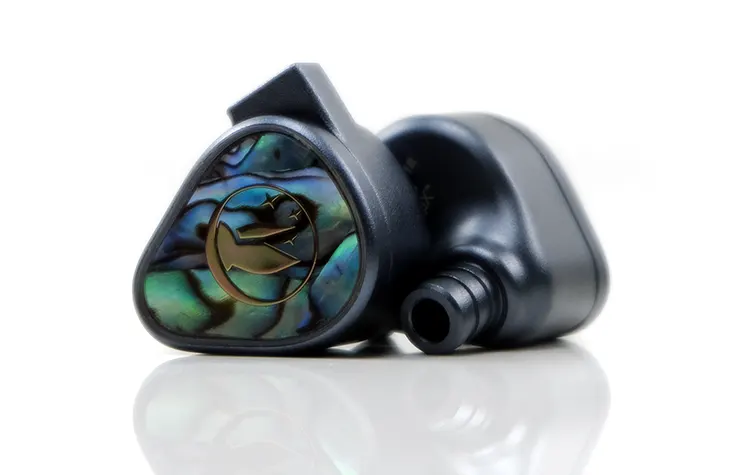Select Comparisons
The following comparisons to the Oriolus Monachaa were completed using a mix of the Cayin N7, Chord Electronics Mojo 2, and the HiBy R8 II as both source and amplification. All compared IEMs were fitted with their respective balanced 4.4mm stock cable and ear tips.
Campfire Audio Trifecta
The Campfire Audio Trifecta was launched in 2023 and is their flagship IEM based on its price point in the company’s lineup. Since the launch CA has periodically refreshed the lineup with different designs. The unit we reviewed in 2023 is the Astral Plane version.
Technical
This is a quad dynamic driver (Monachaa) versus a triple dynamic driver, (Trifecta), comparison.
CA has opted to stack the inside of the Trifecta with three of their classic full-range 10mm A.D.L.C. drivers, positioned in a unique triangular formation facing each other, and firing into a central acoustic chamber then out via a wide nozzle or spout.
That is quite a contrast from Oriolus’s variable dual 10mm, single 5mm, and square driver sizing with each drive finished with a different diaphragm material and covering dedicated aspects of the frequency spectrum.
Both come with wide nozzle spouts for their respect tubing though the Trifecta’s nozzle is not terminated with dedicated bores, perhaps more of a horn principle behind that steel grill finish on the tip.
CA uses a different benchmarking system for the Trifecta’s sensitivity rating. They work on a Vrms to hit a dB benchmark and in this case, the Trifecta requires 16.91 mVrms to hit 94 dB SPL @ 1kHz.
The Monachaa has a more traditional rating of 111dB/mW for SPL with a slightly higher impedance of 24Ω as opposed to the Trifecta’s 6.3Ω rating.
Since there is no like-for-like apart from impedance I can tell you from my subjective testing using the 4.4mm balanced output of the HiBy R8 II in low gain, the Trifecta is much the easier of the two IEMs to drive.
Design
The Trifecta form factor is very unique making the Monachaa look much more like the traditional offering in both shape and finish. There are some pros and cons to each.
At first glance, the Trifecta is the attention grabber with its almost triangular form factor comprised of a nylon material rather than resin.
The Trifecta’s housing is precise but also smoothly curved on each edge and finished with some striking gold PVD finishing on its elongated beryllium/copper ‘MMCX Capture’ stems, faceplate logos, and stainless-steel spout.
It is so different from the Monachaa that I would have a hard time saying which is bigger due to the contrast. You could argue the Trifecta is taller and slightly flatter at best.
That flatness though might be considered a slight con as the fitting is not quite as snug as the Monachaa. With both IEMs fitted with their stock silicone tips, the Monachaa also has a superior level of passive isolation.
Both IEMs are greatly affected both in performance and seal with the tip choices. I prefer silicone on both as they give the bass impact and open sound but the foam tips do isolate better, especially on the Trifecta. In turn, the foam deteriorates the Trifecta dynamics sounding less open.
Cables are also quite different. Both are good quality just different approaches with the Trifecta coming with no less than 3 Time Stream Series flat 8-core SPC cables in 4.4mm, 3.5mm, and 2.5mm, and the Monachaa with just one cable, the braided and black finished OFC copper ‘Ensembl’ with a 4.4mm termination.
Performance
To steal from the movie scene, the Trifecta presentation is like ‘everything, everywhere, all at once’. In contrast, the Monachaa delivery feels like it has an order to its delivery with each driver coming in as and when required.
How does that all translate into tangible differences? Well, the Trifecta is the more striking if you want pure bass aggression, punch, and bloom.
It is the IEM I would pick if I were looking for a concussive low-end performance. It is exciting, albeit slower in driver response with a longer decay, but still a sheer wall of brute force power.
The Monachaa has less mid-bass punch, a more neutral upper-bass, and lower mids. It is not going to wow you with lower-mid thickness or bloom.
However, listen carefully and you will pick up on the slightly better sub-bass presence of the Monachaa over the Trifecta.
We are talking sub-50Hz here so it’s not always called into action but when it hits it is noticeable. More so given the more neutral upper bass which emphasizes the Monachaa’s bass to mids separation.
Speaking of which, the Monachaa drivers handle the mids better than the Trifecta, especially if the bass has a bit of energy. It’s more open sounding, slightly leaner, and lighter in tone, and, with a stronger 800-2k rise, it also has a superior vocal presence.
The Monachaa’s square tweeter seems to have more upper treble energy compared to the Trifecta, exhibiting a little more upper mids sheen. It does help to tease out a little more detail with a slightly shorter decay in the upper register.
qdc Dmagic 3D
The qdc Dmagic 3D was launched in late 2020 with our review published in early 2021. At a time when multi-dynamic driver IEMs were rare and not very well implemented the 3D’s excellent tuning was like a breath of fresh air. They still sell at Musicteck USA if you want to check it out.
Technical
Another triple dynamic driver universal IEM, the Dmagic 3D comes with a dual 10mm dynamic driver for the lows and the mids and an 8mm compound dynamic driver for the highs using a 3-way crossover.
The Monachaa also splits its 10mm drivers for the lows and mids but adds a 5mm driver for the mid/highs and the square tweeter for the ultra highs.
Like the Monachaa, the Dmagic 3D drivers also use differing diaphragm materials. In this case, we have a 10mm graphene vibrating diaphragm, a titanium-plated vibrating diaphragm compound variant, and a single smaller 8mm compound vibrating diaphragm.
The Dmagic 3D is not as efficient on paper at 98 dB/mW compared to the Monachaa at 111 dB/mW but in reality, the Dmagic is the more sensitive of the two for both volume and gain using our test DAP, the HiBy R8 II, in a balanced 4.4mm low gain mode.
At 13.5Ω versus 24Ω, the required load gap is not big enough to create a big enough gap in loading requirements so both will be fine off most portable sources though I advise going balanced as they scale a bit more in terms of performance quality.
Design
The Monachaa is the better of the two for its more compact form factor despite it having 4 drivers inside instead of 3. However, the Dmagic 3D has the more appealing aesthetic and is something qdc has always been known for, at least for the units I have reviewed.
The Dmagic 3D aesthetic is a a gorgeous base wood with a stabilizing resin and a lot of dye blending to get a beautiful deep and richly diverse nebula swirl design. It’s a standout design for universal IEMs and not just against the Monachaa.
The Oriolus design is smaller but, more importantly, its thicker spout and tip combo provides a more secure fit and a slightly better seal compared to the Dmagic 3D. You can get close with the dual flange stock tips for the Dmagic 3D but it never feels quite as secure in the ear.
Probably the biggest drawback of the qdc design is the cable and connector system with its reversed polarity 2-pin 0.78mm connectors. It makes cable rolling more of a challenge unless you have converters or a cable with a qdc termination.
The stock cable is just ok also on the Dmagic 3D. The wiring is competitive with a 26AWG-sized copper and silver mix inside an 8-core parallel wire geometry.
It is also lighter but not to the same quality of finishing as Monachaa’s stock cable ‘Ensembl’ design. Its big benefit is the interchangeable socket system which comes with 4.4mm, 3.5mm, and 2.5mm options.
Performance
Both of these IEMs are going for a presentation that is more restrained than the Trifecta with the Dmagic 3D more to the richer and warmer side and the Monachaa a cooler and airier performer.
There are a couple of big tuning differences for me that go some way to creating that impression. First, the Monachaa has more sub-bass presence and quality but less mid-to-upper bass bloom which is where the Dmagic 3D focuses on.
That means more depth and power in the Monachaa’s staging with enhanced bass-to-mids separation and a slightly fuller sounding lower-mids from the Dmagic 3D.
The second big difference is the upper-mids and lower treble or roughly 3-7k where the Dmagic 3D is a lot calmer, perhaps south of neutral for energy and air whereas the Monachaa exhibits a more forward and energetic equivalent.
Both IEMs have a similar 1-2k bump but because of the scooped lower-mids and more energetic upper-mids, the timbre of the Monachaa vocals is cleaner, lighter, and surrounded by more space and air.
The Dmagic vocal timbre benefits from more upper-bass and lower-mids warmth but lacks space and air from the attenuated upper-mids and treble so it sounds a bit muddier and with less separation.
Overall, the Monachaa is the bigger-sounding performer with more depth and an airier set of mids and highs. The Dmagic 3D has a stronger focus on the lower-mids and a smoother tone but is the less revealing and dynamic of the two IEMs.
FIR Audio e12 (Electron 12)
One of our most recent reviews, and down from 4 drivers to a single, but no less potent, dynamic driver IEM. The FIR Audio e12 was the company’s most recent launch alongside the smaller e10 and their debut dynamic driver IEM.
Technical
The e12 uses a single 12mm electro-dynamic driver as opposed to the Monachaa’s 4-driver configuration. The unique feature of the e12 driver is a technical pitch from FIR Audio called Tactile Bass Technology.
The information on this is not huge but it seems to be a marriage of both shell and driver in such a manner as to create a second transducer effect for the lows. This enhances reverberation and creates a tactile effect similar to the lows of their high-end Kinetic Bass models such as the Radon 6 and Krypton 5.
The e12 also comes equipped with an internal ATOM pressure system equivalent to FIR’s Yellow filter rated at 17 dB for pressure isolation. This is one of their stronger modules for bass amplitude at +2 dB over their neutral silver ATOM filter benchmark.
The e12 is rated at 16Ω which is a little lower than the Monachaa’s 24Ω rating but as always with FIR Audio there is no SPL number. From my subjective testing using the Cayin N7 in a low gain balanced 4.4mm configuration, the e12 is by far the more sensitive of the two IEMs for volume and gain.
Design
The e12 is of a similar size and form factor when compared to the Monachaa but it is the heavier of the two IEMs courtesy of its aluminum shell housing.
Metal housing’s more rigid lines always tend to be less forgiving for passive isolation capability so the Monachaa is more comfortable in the ear and also isolates a bit better, even when comparing foam on the e12 and silicone on the Oriolus design.
Where the e12 is more unique is in the aesthetics with its magnetic SwapX face plate technology which allows you to create your plate designs or pick from a wide variety of off-the-shelf designs when checking out your purchase on the FIR Audio website.
With the Monachaa, the design is professional, smooth, and complimentary but it’s just one design and not massively engaging on the level of the Dmagic 3D.
The cables on both are of excellent quality. The e12 stock cable is a balanced terminated 48″ 26AWG 8-wire geometry with pure silver and copper shielding whereas the PW Audio-partnered Monachaa ‘Ensembl’ cable is OFC copper but of unknown gauge and core count.
The finish on both is very different. The lighter e12 cable uses loosely twisted transparent PVC so the copper shines through on a slimmer cable design whereas the Ensemble is heavier, and chunkier with a more elaborate braiding technique and all matte black from head to toe.
Performance
The initial impression that stands out between these two is the additional tonal density of the e12 compared to the more ethereal quality of the Monachaa, particularly through the mids.
I switched to foams on the Monachaa for this comparison since I tend to use foams on the e12 by default. That shifts the tonal quality of the Monachaa more to a slightly smoother but relatively more ‘distant’ presentation.
This imaging ‘pushback’ doesn’t occur with the e12/foam presentation. It has a more aggressive and forward-sounding soundstage courtesy of a longer bass shelf right up into the lower mids around 500Hz before it hits the same spot as the Monachaa.
Despite the sub-bass of the Monachaa being slightly more lifted at 50Hz, its more neutral mid-to-upper bass quantity takes away some of that density and warmth from the e12 lows and in turn that gives it a lighter airier timbral quality through the mids and highs.
The Monachaa highs are also a little more exuberant and sparkling with more of an 8k lift and less of a 5k push which is where I find the e12 at its strongest.
That is pretty much why I have foams on the e12 as I am more sensitive to harmonic dissonance in that region. I can use the silicone tips on the Monachaa because its upper mids have less of a 5k peak and sound less aggressive.
Of the two IEMs, the Monachaa is the airier of the two presentations translating to a little more headroom, width, and a cleaner middle-register vocal sound. The E12 will be perceived as closer sounding, more forward, and weightier on the lows, as well as delivering a firmer and more intimate higher register vocal performance.
Our Verdict
The Oriolus Monachaa is a cleverly tuned quad-dynamic driver IEM. It does not seek to smash the audible door down but rather pick it open quietly with some deft precision.
It hits beautifully on the lows when it needs to with some quality sub-bass presence but can sound surprisingly articulate and clear in the mids and highs.
If there are some caveats it’s purely personal such as the uninspiring aesthetics and the slight 8k bump in the tuning coming through when using the comfier silicone tips. These can be remedied with foam tips or a warmer source.
Aside from that, it’s a very mature-sounding musically-tilted IEM with excellent power and very good levels of detail. Just what you should expect from a good quality multi-driver in-ear monitor.
Oriolus Monachaa Technical Specifications
- Body Material Photopolymer (handcraft)
- Transducer Type (per CH) Dynamic Driver*4
- Sensitivity 111dB/mW
- Freq. Response 20Hz~40kHz
- Impedance 24Ω
- Cable made by PW Audio (Order made, Copper)
- Plug Type 4.4mm Balanced





